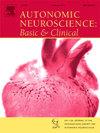女性,直立容忍度,和盆:一个叙事回顾
IF 3.3
4区 医学
Q2 NEUROSCIENCES
引用次数: 0
摘要
年轻女性比男性更容易出现站立不耐受。在健康和病理生理条件下,许多生理途径可能导致这种不耐受。这篇综述讨论了血液动力学、通气、自主控制和脑血流的性别差异。此外,我们讨论了这些现象及其在体位性心动过速综合征(POTS)中的潜在恶化。在身体尺寸正常化后,女性中风量和血容量降低,而直立女性通气减少,静脉回流减少,可能是由于呼吸泵和骨骼肌泵活动减弱,副交感神经退出增强,交感神经血管传导减弱,与年龄匹配的男性相比,血管舒张能力增加。女性的大脑中动脉血流速度更快,这可能会损害大脑动态自动调节(取决于时间),但两性之间存在类似的脑血管对二氧化碳的反应。因此,我们认为女性直立不耐受发生率较高主要是由于血流动力学控制和自主神经功能;然而,直立时增强的副交感神经退缩在理论上可能影响脑血管舒张能力,这一可能性有待进一步研究。由于其通过covid - 19后感染而增加,因此简要描述了POTS生理学。我们总结了POTS的一些潜在生理变化,包括血流动力学和通气控制,并强调脑血流控制受损,可能在POTS的症状中起作用。本文章由计算机程序翻译,如有差异,请以英文原文为准。
Women, orthostatic tolerance, and POTS: a narrative review
Young women experience orthostatic intolerance to a greater degree than men. Numerous physiological pathways could be responsible for this intolerance in both healthy and pathophysiological conditions. This review discusses sex differences in hemodynamics, ventilation, autonomic control, and cerebral blood flow. Further, we discuss these phenomena and their potential exacerbations in postural orthostatic tachycardiac syndrome (POTS). After normalization for body size women have lower stroke volume and blood volume, and while upright women have reduced ventilation, reduced venous return likely from attenuated respiratory pump and skeletal muscle pump activity, augmented parasympathetic withdrawal, attenuated neurovascular transduction of sympathetic outflow, and increased vasodilatory capacity compared to age-matched men. Women have greater middle cerebral artery blood velocity, potentially impaired cerebral dynamic autoregulation (depending on the timing), yet similar cerebrovascular reactivity to carbon dioxide exists between the sexes. Thus, we suggest that the greater incidence of orthostatic intolerance in women is primarily due to hemodynamic control and autonomic function; however, the enhanced parasympathetic withdrawal while upright could theoretically influence cerebral vasodilatory capacity and is proposed as a possibility in need of further investigation. POTS physiology is described briefly due to its increasing prevalence via post-COVID infections. We summarize some potential physiological changes in POTS including hemodynamic and ventilatory control, and we highlight that cerebral blood flow control is impaired and likely plays a role in the symptomology of POTS.
求助全文
通过发布文献求助,成功后即可免费获取论文全文。
去求助
来源期刊
CiteScore
5.80
自引率
7.40%
发文量
83
审稿时长
66 days
期刊介绍:
This is an international journal with broad coverage of all aspects of the autonomic nervous system in man and animals. The main areas of interest include the innervation of blood vessels and viscera, autonomic ganglia, efferent and afferent autonomic pathways, and autonomic nuclei and pathways in the central nervous system.
The Editors will consider papers that deal with any aspect of the autonomic nervous system, including structure, physiology, pharmacology, biochemistry, development, evolution, ageing, behavioural aspects, integrative role and influence on emotional and physical states of the body. Interdisciplinary studies will be encouraged. Studies dealing with human pathology will be also welcome.

 求助内容:
求助内容: 应助结果提醒方式:
应助结果提醒方式:


